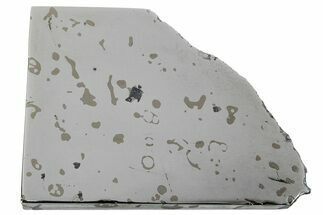This Specimen has been sold.
2.1" Gleaming Dronino Iron Meteorite Slice (104.1 g) - Ryazan, Russia
This is a shiny, 2.1" wide (104.1 gram) slice of the Dronino iron meteorite discovered in the Ryazan Region of Russia. It has been polished to a mirror like finish.
The Dronino Meteorite
The Dronino meteorite was first discovered in 2000 by a resident of Moscow, Russia while he was collecting mushrooms at the village of Dronino, southeast of the metropolitan area. In 2003, researchers and meteorite hunters collected over 600 fragments weighing about 3,000 total kilograms over a 0.75 square kilometer strewn field. The fragments' distribution suggests a 30-meter crater that is no longer visible.
Dronino's fall was unobserved, but it likely fell at least 1,000 years ago, before the village of Dronino existed. Most fragments are heavily weathered as a result of alkaline soils and wet surface conditions in the area.
Dronino is an ataxite meteorite, a kind of iron meteorite with high nickel content that shows no Widmanstätten patterns when etched. Dronino contains sulfide inclusions (~10% by volume) and smaller amounts of kamacite and taenite, which contribute to the interesting pockets and textures on polished surfaces. It is classified as an ungrouped iron meteorite since it is chemically unrelated to the other iron meteorite groups. Less than 10% of iron meteorites fall into this ungrouped iron classification.
The Dronino meteorite was first discovered in 2000 by a resident of Moscow, Russia while he was collecting mushrooms at the village of Dronino, southeast of the metropolitan area. In 2003, researchers and meteorite hunters collected over 600 fragments weighing about 3,000 total kilograms over a 0.75 square kilometer strewn field. The fragments' distribution suggests a 30-meter crater that is no longer visible.
Dronino's fall was unobserved, but it likely fell at least 1,000 years ago, before the village of Dronino existed. Most fragments are heavily weathered as a result of alkaline soils and wet surface conditions in the area.
Dronino is an ataxite meteorite, a kind of iron meteorite with high nickel content that shows no Widmanstätten patterns when etched. Dronino contains sulfide inclusions (~10% by volume) and smaller amounts of kamacite and taenite, which contribute to the interesting pockets and textures on polished surfaces. It is classified as an ungrouped iron meteorite since it is chemically unrelated to the other iron meteorite groups. Less than 10% of iron meteorites fall into this ungrouped iron classification.
About Iron Meteorites
Iron type meteorites are composed primarily of iron and nickel, and are the remnants of differential cores torn apart at the beginning of the solar system. These metallic meteorites are often the easiest to identify after millions of years post-impact because they are quite different from terrestrial material, especially when it comes to their mass-to-surface area ratio. They are exceptionally heavy for their size since iron is a high-density metal: this is also why the Earth's core is nickel-iron. As planets form, the densest metals form gravitational centers, bringing more and more material into their gravitational pull. In the solar system's rocky planets, these dense materials are most often nickel and iron.
Most iron meteorites have distinctive, geometric patterns called Widmanstätten patterns, which become visible when the meteorite is cut and acid etched. These patterns are criss-crossing bands of the iron-nickel alloys kamacite and taenite that slowly crystalized as the core of the meteorites' parent bodies slowly cooled. Such large alloy crystallizations for mover millions of years and do not occur naturally on Earth, further proving that iron meteorites come from extraterrestrial bodies.
Iron type meteorites are composed primarily of iron and nickel, and are the remnants of differential cores torn apart at the beginning of the solar system. These metallic meteorites are often the easiest to identify after millions of years post-impact because they are quite different from terrestrial material, especially when it comes to their mass-to-surface area ratio. They are exceptionally heavy for their size since iron is a high-density metal: this is also why the Earth's core is nickel-iron. As planets form, the densest metals form gravitational centers, bringing more and more material into their gravitational pull. In the solar system's rocky planets, these dense materials are most often nickel and iron.
Most iron meteorites have distinctive, geometric patterns called Widmanstätten patterns, which become visible when the meteorite is cut and acid etched. These patterns are criss-crossing bands of the iron-nickel alloys kamacite and taenite that slowly crystalized as the core of the meteorites' parent bodies slowly cooled. Such large alloy crystallizations for mover millions of years and do not occur naturally on Earth, further proving that iron meteorites come from extraterrestrial bodies.
TYPE
Iron (Ungrouped)
LOCATION
Ryazan Region, Russia
SIZE
2.1 x 1.81", up to .27" Thick, Weight: 104.1 grams
CATEGORY
SUB CATEGORY
ITEM
#264922
 Reviews
Reviews












